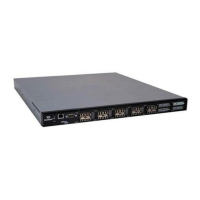5–Managing Switches
Managing Switch Stacks
5-26 59266-01 B
switch management application (GUI). After enabling the SSL service, you
must then log off the fabric and log on again to establish a secure
connection. To disable SSL when using a user authentication RADIUS
server, the RADIUS authentication order must first be set to Local.
Telnet (Command line interface)—enables users to manage the switch
through a Telnet command line interface session. Disabling Telnet access to
the switch is not recommended.
SSH (Secure SHell)—enables secure encrypted Telnet command line
interface sessions with the switch. To manage a switch over a secure Telnet
connection, the SSH service must be enabled, and an SSH client must be
running on your workstation.
SNMP (Simple Network Management Protocol)—enables management of
the switch through third-party applications that use SNMP.
NTP (Network Time Protocol)—enables the switch to obtain its time and
date settings from an NTP server. Configuring NTP on all of your switches
and your workstations synchronizes the date/time settings across the fabric
and prevents difficulties with SSL certificates and event logs.
CIM (Common Information Model)—enables management of the switch
through third-party applications that use CIM.
FTP (File Transfer Protocol)—enables file transfers to the switch using FTP.
FTP is required for out-of-band firmware uploads, which complete faster
than in-band firmware uploads.
Management Server—enables management of the switch through
third-party applications that use the GS-3 Management Server.
Call Home—enables you to configure switches and send alerts and events
to email addresses or pagers.
Managing Switch Stacks
The Enterprise Fabric Suite application recognizes switches as a stack if they are
connected by their high-speed XPAK stacking ports. Enterprise Fabric Suite
auto-detects switches connected by their XPAK ports and displays these stacked
switches as a single stack entity in the faceplate display (Figure 5-7).
The graphic window (upper right pane of the faceplate display) displays one
faceplate image for each switch in the stack.
In the fabric tree (left window pane), the switches in each stack are nested under
the stack icon that is nested under the fabric icon. Expanding the fabric and stack
icons in the fabric tree displays all switches in a stack. The lock image on the
fabric icon indicates that the application is communicating with the fabric through
a secure (Secure Sockets Layer) connection.

